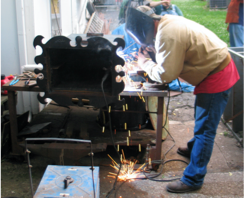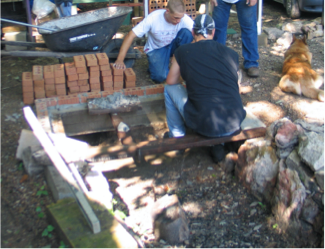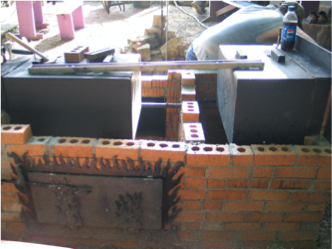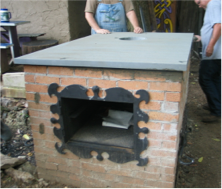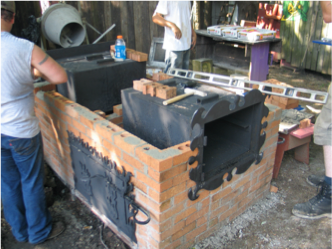Food, glorious food
At lunchtime during faire days the savory aromas float through the air around the blacksmith shop, teasing the patrons. IHEA volunteers take turns filling their plates with warm food cooked specially for them in the outdoor kitchen. They dine on roasted meats, biscuits and stewed vegetables. Some days it’s soul-warming casseroles or stew. Patrons often look at the diners and ask where to purchase the meal. Alas, for them, it is not for sale, but earned by the hard work of the volunteers who demonstrate the various arts and crafts for IHEA.
In the beginning, there was only a small pit for open-fire cooking. Nothing fancy. But for two years, that’s what Marcellina used to prepare meals for the 20+ members of IHEA during Renfest. Soups were a mainstay in those days, but Marcellina also managed biscuits and desserts—anything that could be cooked in a dutch oven atop the wood-burning flames.
After a couple of years, Cedric designed and built an oven for Marcellina to use. Built in the same footprint as the current oven, the first one consisted of a 10-gauge sheet steel frame clad in brick, with a removable metal plate Marcellina could place on top to use like a griddle. Inside, a single shelf was large enough to hold two pans at a time. The oven comprised only half the size of the structure, however; the other half was a smoker.
The new oven/smoker/cooktop opened a whole new world of meal possibilities for Marcellina and the IHEA crowd: breads, roasts, oven-fried chicken, desserts. Basically, anything Marcellina could cook at home was now possible to cook out at the fairgrounds, and she did. Marcellina used the oven for several years, until the steel frame rusted out and a shifting foundation began to tear it apart about five years ago.
That’s when Cedric redesigned and rebuilt the oven using much thicker (¼”) steel, hoping the redesign would last even longer than the previous oven had. Because IHEA had grown to between 50 and 60 members since the last oven design, Mom had the smoker converted into another oven, doubling the amount of baking she could do at one time. Next to the structure, the team dug a fire pit, over which are two hinged pot hooks for cooking soups and stews over open fire. There’s also a roasting spit installed over the pit for whole-hog roasting. IHEA blacksmiths forged the oven doors, pot hooks, hinges, spit, and trammel hooks Marcellina uses to cook for all IHEA members.
One of the biggest learning curves was learning about different types of wood and how best to cook with each. Some woods put off too much heat, others not enough; some woods burn too quickly to maintain an even cooking temp.
- Walnut: burns fast and hot – took oven to over 500 degrees, then dropped
- Hedge/Osage Orange: burns even hotter/faster than walnut
- Ash/Oak: Even burning at a lower temperature; good for a steady cook temp
- Elm: no good for cooking, it just slow-ashes without giving off heat
- Hard woods: best to use because they’re consistent burning over a longer period of time
Marcellina has a thermometer in the oven, “but I use the crack instead.” There’s a crack in the mortar on one side of the oven, and Marcellina noticed that it gapes at a certain temperature. So now she uses that to cook by instead of opening the oven door to look at the thermometer.
When asked what might be next for the kitchen, Marcellina said she feels it’s complete at this point. Now her goal is to train others to take her place so she can “retire” to the sidelines. “I’ll still be here – wouldn’t know what else to do. It can be tiring, but I love it.” So what does retirement mean for her? “I’ll sit right here [in the shade] and choose what to help with.”


